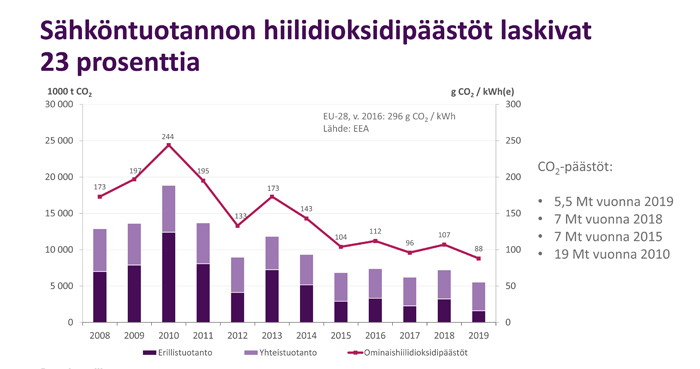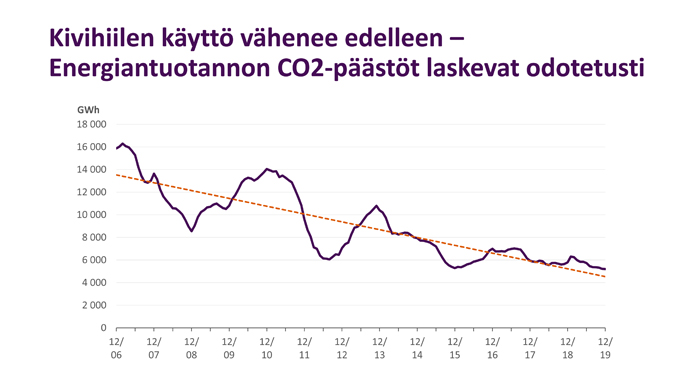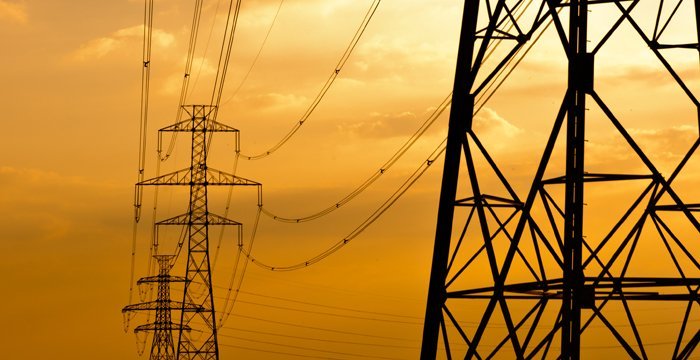03.01.2020, kello 15.10
Sähköntuotannosta jo 82 prosenttia päästötöntä
Päästöt jatkoivat laskuaan
Suomi käytti viime vuonna sähköä hitusen vähemmän kuin vuotta aikaisemmin. Samalla suomalaisen sähköntuotannon hiilidioksidipäästöt jatkoivat laskuaan.

Suomalaiset käyttivät 86 terawattituntia sähköä vuonna 2019. Tämä on 1,7 prosenttia vähemmän kuin vuotta aikaisemmin. Merkittävin syy sähkönkäytön supistumiseen oli metsäteollisuuden vähentynyt sähkön tarve.
Teollisuuden osuus Suomessa käytetystä sähköstä oli viime vuonna 45 prosenttia — sähköksi muutettuna 39 terawattituntia. Suomalaisessa teollisuustuotannossa tapahtuvat suhdannevaihtelut heijastuvat yleensä herkästi sähkön kysyntään. Tämä näkyy myös sähkön kokonaiskysynnässä.'
Metsäteollisuus suurin käyttäjä
Teollisuustoimialoista suurin sähkönkäyttäjä on metsäteollisuus. Se käytti viime vuonna sähköä 18,9 terawattituntia. Metalliteollisuuden yritysten osuus oli 8,4 terawattituntia ja kemianteollisuuden 7 terawattituntia. Muut teollisuustoimialat käyttivät sähköä yhteensä 4,5 terawattituntia.
Kotitaloussähkön käytössä suhdanteet eivät näy — tai jos näkyvät, niin taantuma ja työttömyyden kasvu päinvastoin lisäävät kotitaloussähkön käyttöä, kun kansalaiset ovat enemmän kotona kuin töissä.
Kotitalouksien sähkönkäyttöön vaikuttaa eniten ulkolämpötila. Mitä kylmempi talvi on, sitä enemmän kodeissa kuluu lämmitysenergiaa. Esimerkiksi sähkölämmitteisessä omakotitalossa lämmityksen osuus kotitalouden sähkönkäytöstä voi olla jopa puolet. Kotitalouksissa sähköä tarvitaan myös käyttöveden lämmittämiseen, valaistukseen ja kodinkoneiden pyörittämiseen. Viime vuonna kotitalouksien sähkön käyttö kasvoi hitusen: 0,2 terawattituntia.

Hiilidioksidipäästöt romahtivat
Suomalainen sähköntuotanto päästeli viime vuonna ilmaan 5,5 miljoonaa tonnia hiilidioksidia. Tämä on 23 prosenttia vähemmän kuin viime vuonna. Huippuvuonna 2010 suomalainen sähkötuotanto aiheutti 18,8 miljoonan tonnin hiilidioksidipäästöt. Sähköntuotannon päästöt ovatkin painuneet kohti pohjalukemia nopeasti ja rajusti. Vertailun vuoksi: vuonna 2018 Suomen kaikki yhteenlasketut hiilidioksidipäästöt olivat noin 57 miljoonaa tonnia.
— Suomalaisen sähköntuotannon hiilidioksidipäästöt eivät ole koskaan olleet näin alhaalla, riemuitsee Energiateollisuus ry:n toimitusjohtaja Jukka Leskelä.
Syynä päästöjen supistumiseen on kivihiilen ja turpeen käytön väheneminen sähköntuotannossa. Erityisen vahvasti tämä näkyy sähkön erillistuotannossa. Viime vuonna sähköä tahkottiin erillistuotantolaitoksilla puolet vähemmän kuin vuotta aikaisemmin.
— Kivihiilen käyttö sähkön erillistuotannossa laski 52 prosenttia ja turpeen käyttö 48 prosenttia, Leskelä huomauttaa.
Tällä hetkellä EU:n päästökauppa näyttää ohjaavan sähköntuotannon polttoainevalintoja tehokkaasti. Kun päästöoikeuksien hinnat nousevat, aiheuttaa päästöoikeuksien ostaminen kustannuksia fossiilisia polttoaineita käyttäville yhtiöille. Tämä heikentää fossiilisten polttoaineiden kilpailukykyä, jolloin investoinnit ohjautuvat markkinaehtoisesti päästöttömiin tuotantomuotoihin.
— Fossiiliset polttoaineet poistuvat nopeasti markkinoilta. Viime vuonna kivihiilen osuus sähköntuotannossa laski yhdeksästä prosentista seitsemään ja turpeen viidestä neljään prosenttiin, Leskelä kertoo.
— Kehitys jatkuu samansuuntaisena. Investoinnit ohjautuvat mm. tuulivoimaan, jonka kapasiteetti kasvoi viime vuonna jopa 12 prosenttia.

Ydinvoima kärjessä
Suomalaisessa sähköntuotantopaletissa ydinvoiman osuus on suurin — 35 prosenttia. Kakkosijalla on vesivoima 19 prosentin viipaleella. Biomassoilla sähköä tuotetaan lähes yhtä paljon: 18 prosenttia.
Tuulivoiman osuus on kasvanut kaikkein nopeimmin. Kasvua on vauhdittanut tuulivoiman kilpailukyvyn parantuminen: uusia tuulivoimalaitoksia rakennetaan jo ilman valtiollisia tukia. Viime vuonna Suomeen valmistui 79 uutta tuulivoimalaitosta, joiden tuotanto tosin ei vielä näy täysimääräisesti tilastoissa.
Tuulivoiman osuus suomalaisesta sähköntuotantopaletista oli viime vuonna jo yhdeksän prosenttia. Tuulivoima on pysyvästi ohittanut kivihiilen, maakaasun ja turpeen. Kivihiilen osuus sähköntuotannossa kutistui vastaavasti viime vuoden aikana yhdeksään prosenttiin. Maakaasun osuus oli kuusi prosenttia ja turpeen neljä. Jätteiden osuus oli prosentin ja aurinkovoiman 0,2 prosenttia.
KAINALOSSA
Tuontia ja vientiä kotimarkkinoilla
Suomessa tuotetusta sähköstä suurin osa — noin 70 prosenttia — vaihtaa omistajaa pohjoismaisessa sähköpörssissä. Kotitalouksille ja yrityksille sähköä myyvät energiayhtiöt taas ostavat sähkönsä suurimmaksi osaksi samaisesta pörssistä.
Suomi on kiinteä osa pohjoismaisia sähkömarkkinoita. Monen energiayhtiön kannalta pohjoismaiset sähkömarkkinat ovat peräti kotimarkkina-alue. Tämä tarkoittaa sitä, että kaupallisessa mielessä kansallisia rajoja ei enää ole. Tulevaisuudessa koko Euroopan unionin pitäisi muodostaa tiivis ja saumaton sähkömarkkina-alue.
Markkinaintegraatiosta huolimatta tilastonörtit puhuvat sähkön tuonnista ja sähkön viennistä, kun sähkö liikkuu esimerkiksi Ruotsista Suomeen tai päinvastoin. Miten yhtenäisen markkina-alueen sisälle on jäänyt tuonnin ja viennin kaltaisia kummajaisia. Samalla periaatteella Rovaniemeltä voitaisiin tuoda sähköä Helsinkiin.
Euroopan unionin perusidea on hyödykkeiden vapaa liikkuvuus. Kun sähkö liikkuu vapaasti yhtenäisellä markkina-alueella, niin miten kansalliset rajat ylittävä kauppa on tästä huolimatta vienti- tai tuontikauppaa. Tämän periaatteen mukaan Suomeen tuodaan sähköä vain Venäjältä, koska Venäjä ei ole EU:n jäsen.
Oli miten oli. Sähkötilastoissa on yhä sellainen käsite kuin sähkön nettotuonti. Se on tuonnin ja viennin välinen erotus. Viime vuonna nettotuonnin osuus suomalaisesta sähkönhankinnasta oli 23 prosenttia. Onko tämä paljon vai vähän? Kyllä ja ei ole — tämä riippuu siitä, keneltä asiaa kysyy.
Sähkökaupan ammattilaisen näkökulmasta aktiivinen sähkön tuonti ja vienti on merkki siitä, että sähkömarkkinat toimivat. Sähköä siis kannattaa myydä aina sinne, mistä siitä saa parhaan hinnan ja ostaa sieltä, mistä sähkö halvimmalla irtoaa. Viis siitä, missä päin voimalaitos maantieteellisesti sijaitsee.
Huoltovarmuusasioita pohtivat eivät ajattele samalla tavalla. Sähköntuotanto pitäisi turvata myös poikkeusoloissa. Siksi voimalaitoksia pitäisi olla myös omasta takaa. Kansantalouden kannalta olisi myös edullista, että maa saisi rajojensa sisälle mahdollisimman paljon työtä ja veroeuroja tuottavia voimalaitosinvestointeja.
teksti Petri Sallinen / pääkuva Scanstockphoto





Kommentit
e
e
e - ti helmik. 25 09:40:24 2025
ts
me: yogurt
gurt: ts pmo sybau
normal - ke huhtik. 16 13:49:46 2025
(Ei otsikkoa)
me: shut up
up:sybau gurt
Yo: yogurt
Gurt: kys
pmo - ke toukok. 14 09:19:47 2025
(Ei otsikkoa)
NI : GA
PMO
YOU : STUPID NIG
TRALLALLAA
SYBAU
GO FU
neg - ke toukok. 14 09:22:35 2025
Hoi roope
Lowk annika pmo
pmo - ke toukok. 14 09:22:48 2025
Hoi roope
oisko lähteen koululle S-46A pommi
pmo - ke toukok. 14 09:23:28 2025
(Ei otsikkoa)
PMO : POMMITUS KOULULLE NOIN
1.4.0.0 SYBAU
GO: FUCK NIGAS
FUCK :INTIA HAISEE
POMMI IDEA - ke toukok. 14 09:25:12 2025
Hoi roope
Brr brr patapim, patapam, patapum
Brr brr patapim, patapam, patapum
Brr brr patapim, patapam, patapum
Brr brr patapim, patapam, patapum
NEEKERI BRIAN NEEKERI
pmo - ke toukok. 14 09:25:42 2025
Hoi roope
Tralalero tralala
Tralalero tralala
Tralalero tralala
Tralalero tralala
I HATE NIGGAS FUCK NIGGAS NIGGERRRR
pmo - ke toukok. 14 09:26:54 2025
(Ei otsikkoa)
MIETI : JOS OLIS INTIAN LENTOKONEESSA
HYI : VITTU SE SALEE HAISEE SYBAU INTIA
IN :TIA SMELS BAAD
TRALLALLAA NEGAS
KELAA - ke toukok. 14 09:27:50 2025
nekru
skottilaista
Veikko - ke toukok. 14 09:27:50 2025
nekru
TT
Veikko - ke toukok. 14 09:28:59 2025
VEIKKO MÄKELÄ
NEEKERI NEEKERIT HAISEE HEMO PAHALLE
INTIA FUCKERS NEGAA
KELAA - ke toukok. 14 09:29:16 2025
Hoi roope
Mä: Nekrut lowk haisee paskalt
lowk: mitä vittuu ime munaa
Vittuu: sybau
koko maailma: Fuck neekerit
pmo - ke toukok. 14 09:29:19 2025
VEIKKO MÄKELÄ
MIETI JOS OLIS INTIAS
PMO : HYI SAATANA
TT :IMAGINE THE SMELL
SY:BAY
GO: FOUND NE
de - ke toukok. 14 09:32:35 2025
ploh
Mont nekruu pitäs tappaa et matchaa hitlerin ennätyksee?!
ps.fuck neget
niglet - ke toukok. 14 09:32:42 2025
nekru
skottilaista
Stikeorst - ke toukok. 14 09:33:39 2025
ploh
mitä äijät
niglet - ke toukok. 14 09:35:56 2025
nigga
ballsack ojennatko kokiksen
veikko - ke toukok. 14 09:36:15 2025
Gigger
I hate giggers
Eelismikropeenis - ke toukok. 14 09:36:15 2025
nigga
albert ojennatko toisen läski joko joit sen
läski boll
jari - ke toukok. 14 09:37:14 2025
jori
älkää kiusatko mua t veikko
veikko - ke toukok. 14 09:38:07 2025
Lahden paukutetuin
tarvitsen seuraa
P - ke toukok. 14 09:38:22 2025
oscar
voiksä heittää yhe nuuska
jari baari - ke toukok. 14 09:38:50 2025
ploh
Slavery is one of the most devastating injustices in human history, characterized by the ownership and exploitation of individuals as property. It has existed in various forms across cultures and time periods, with the transatlantic slave trade being one of the most infamous examples. Millions of Africans were forcibly taken from their homeland, enduring brutal conditions and lifelong suffering. Slavery dehumanized individuals, stripping them of their dignity, freedom, and basic rights. The abolition of slavery marked significant progress toward human equality, but the legacy of its impact still lingers in modern societies, emphasizing the ongoing need for racial justice and equality.
niglet - ke toukok. 14 09:40:01 2025
arvoitus
bigger
trigger
digger
?igger
baarin jari - ke toukok. 14 09:40:35 2025
ploh
Racism is a deeply ingrained social issue that manifests in discrimination, prejudice, and systemic inequality based on race. It arises from the belief that certain racial groups are inherently superior or inferior to others, a mindset that has led to centuries of oppression and exclusion. Historically, racism has been used to justify slavery, colonization, segregation, and a host of discriminatory practices that have negatively impacted marginalized communities.
At its core, racism thrives on stereotypes, ignorance, and fear of difference. These prejudices are often perpetuated by societal structures, including education, media, and political systems, which can reinforce negative perceptions about certain racial groups. This leads to unequal opportunities in various sectors such as employment, education, healthcare, and the criminal justice system. The impact of racism is not limited to individual experiences of hatred or bias but extends to systemic disparities that affect entire communities.
Racism can take many forms, including overt acts of violence or subtle, unconscious biases that influence decision-making. Microaggressions, which are small but cumulative acts of discrimination, are often dismissed as minor but can have lasting effects on individuals. Furthermore, racism is not confined to any one culture or nation; it is a global issue that affects people worldwide, with historical legacies of colonialism and slavery shaping present-day inequalities.
Combatting racism requires more than just changing attitudes; it necessitates a collective effort to dismantle the systems and structures that perpetuate inequality. Education, open dialogue, and the promotion of empathy are crucial in challenging racial stereotypes. Governments and institutions must also enact policies that promote fairness and equal rights for all, regardless of race. Ultimately, creating a more just and equitable society hinges on recognizing and addressing the root causes of racism.
niglet - ke toukok. 14 09:41:03 2025
oikea vastaus
zipper
jari baari - ke toukok. 14 09:41:20 2025
ploh
The History, Contributions, and Struggles of Black People
Black people have a rich and diverse history that stretches across centuries, continents, and cultures. From ancient African civilizations to the forced displacement through the transatlantic slave trade, the contributions, struggles, and resilience of Black communities have shaped the world in significant ways. This essay explores the history, cultural contributions, and the ongoing challenges faced by Black people, with a focus on the enduring impact of systemic racism and the continued fight for justice and equality.
Early History and African Civilizations
Before the arrival of European colonization, Africa was home to some of the world’s most advanced and sophisticated civilizations. Ancient Egypt, often considered the cradle of civilization, made groundbreaking contributions to mathematics, architecture, medicine, and literature. The kingdoms of Mali, Ghana, and Songhai in West Africa flourished as centers of trade, scholarship, and culture. The rich cultural and technological advancements of these civilizations were remarkable, yet they were often overlooked or misrepresented in European historical narratives.
In addition to these great empires, Africa has a long history of diverse cultures, languages, and traditions that have influenced global art, science, and philosophy. This diversity was stifled, however, with the onset of European colonialism and the Atlantic slave trade, which forever changed the trajectory of Black history.
The Transatlantic Slave Trade and the African Diaspora
The transatlantic slave trade, which lasted from the 16th to the 19th century, marked one of the darkest periods in human history. Over 12 million Africans were forcibly removed from their homeland and transported to the Americas and Europe as slaves. This massive human trafficking operation stripped people of their dignity, culture, and identity, subjecting them to brutal conditions of forced labor and systemic abuse.
The legacy of the transatlantic slave trade has had far-reaching effects on Black people across the globe. In the Americas, Black people were denied basic human rights and treated as property, their families torn apart, and their cultural practices suppressed. In the United States, the institution of slavery became entrenched, leading to the development of a deeply segregated society that would take centuries to dismantle. Even after slavery was abolished, Black people were still subjected to systemic racism, segregation, and disenfranchisement.
The Civil Rights Movement and Struggles for Equality
In the 20th century, the fight for racial equality became a prominent issue in the United States and many parts of the world. The Civil Rights Movement, led by figures such as Dr. Martin Luther King Jr., Rosa Parks, Malcolm X, and others, sought to dismantle institutionalized racism and secure equal rights for Black Americans. The movement faced violent opposition from both individuals and state institutions, but it ultimately led to monumental legal and social changes, including the Civil Rights Act of 1964 and the Voting Rights Act of 1965.
While significant progress was made in dismantling legal segregation, systemic racism persisted in the form of unequal access to education, employment, housing, and healthcare. Black people continued to face discrimination, not only in overt actions but also in more subtle forms like unconscious bias and cultural stereotypes. The fight for racial equality did not end with the Civil Rights Movement, as new challenges emerged in the decades following.
Contributions of Black People to Culture and Society
Despite the many struggles Black people have faced, they have made extraordinary contributions to world culture, science, politics, and the arts. Black musicians, artists, writers, and performers have shaped the cultural landscape in ways that continue to resonate today. Jazz, blues, gospel, hip-hop, and R&B—genres that emerged from African American communities—have had a profound influence on global music, transcending borders and cultures.
In the fields of science and medicine, Black inventors and pioneers have made groundbreaking contributions, often in the face of significant adversity. George Washington Carver, for instance, developed innovative agricultural techniques, while physicians like Dr. Charles Drew revolutionized the practice of blood transfusion. In the political realm, Black leaders like Nelson Mandela, Malcolm X, and Barack Obama have inspired movements for social justice and fought for the rights and dignity of their communities.
The cultural richness of the African diaspora has also produced countless writers, thinkers, and intellectuals, such as Langston Hughes, Maya Angelou, W.E.B. Du Bois, and Chinua Achebe. Their work continues to shape how we understand race, identity, and history, contributing to the ongoing dialogue about racial justice and equality.
Systemic Racism and Ongoing Struggles
Despite these immense contributions, Black people continue to face deep-rooted systemic racism, a pervasive issue that affects almost every aspect of life. In the United States, for example, Black people are disproportionately affected by poverty, unemployment, and incarceration. Studies have shown that Black people are more likely to experience police brutality, face harsher sentencing in the criminal justice system, and struggle with health disparities, including higher rates of chronic illnesses and lower life expectancy.
The Black Lives Matter (BLM) movement, which gained widespread attention after the 2013 acquittal of George Zimmerman in the shooting death of Trayvon Martin, has brought renewed focus to issues of police violence and racial injustice. The movement has highlighted the need for systemic change in law enforcement, education, healthcare, and the economy to address the inequities that persist in society.
Furthermore, the global movement for racial justice has gained momentum in recent years, with protests and calls for reparations, equitable policies, and a re-examination of historical narratives. In many countries, including the United States, there has been a
niglet - ke toukok. 14 09:41:50 2025
moro
mnicguipigpypnoiiggerhuvish
jaarin bari - ke toukok. 14 09:42:20 2025
jynny
silmät ihan punaset ,voiksä heittää mulle rooka yks nuuska 300euroa piikki tänne renksun baarii mä maksan ne perjantaina sit toi on mulle ihan taskurahaa
jari baari - ke toukok. 14 09:43:00 2025